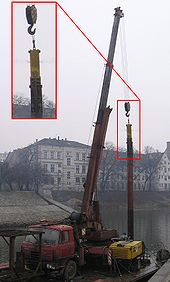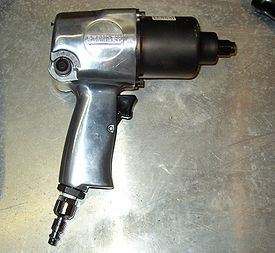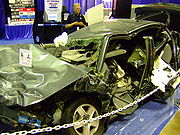
Impact force
Encyclopedia
In mechanics
, an impact is a high force
or shock
applied over a short time period when two or more bodies collide. Such a force or acceleration
usually has a greater effect than a lower force applied over a proportionally longer time period of time. The effect depends critically on the relative velocity of the bodies to one another.
At normal speeds, during a perfectly inelastic collision
, an object struck by a projectile will deform, and this deformation will absorb most, or even all, of the force of the collision. Viewed from the conservation of energy perspective, the kinetic energy of the projectile is changed into heat and sound energy, as a result of the deformations and vibrations induced in the struck object. However, these deformations and vibrations can not occur instantaneously. A high-velocity collision (an impact) does not provide sufficient time for these deformations and vibrations to occur. Thus, the struck material behaves as if it were more brittle than it is, and the majority of the applied force goes into fracturing the material. Or, another way to look at it is that materials actually are more brittle on short time scales than on long time scales: this is related to time-temperature superposition
.
Different materials can behave in quite different ways in impact when compared with static loading conditions. Ductile materials like steel
tend to become more brittle
at high loading rates, and spalling may occur on the reverse side to the impact if penetration doesn't occur. The way in which the kinetic energy is distributed through the section is also important in determining its response. Projectiles apply a Hertzian contact stress at the point of impact to a solid body, with compression stresses under the point, but with bending
loads a short distance away. Since most materials are weaker in tension than compression, this is the zone where cracks tend to form and grow.

 A nail is pounded with a series of impacts, each by a single hammer
A nail is pounded with a series of impacts, each by a single hammer
blow. These high velocity impacts overcome the static friction between the nail and the substrate. A pile driver
achieves the same end, although on a much larger scale, the method being commonly used during civil construction projects to make building and bridge foundations. An impact wrench
is a device designed to impart torque impacts to bolts to tighten or loosen them. At normal speeds, the forces applied to the bolt would be dispersed, via friction, to the mating threads. However, at impact speeds, the forces act on the bolt to move it before they can be dispersed. In ballistics
, bullets utilize impact forces to puncture surfaces that could otherwise resist substantial forces. A rubber sheet, for example, behaves more like glass at typical bullet speeds. That is, it fractures, and does not stretch or vibrate.
 Road traffic accidents usually involve impact loading, such as when a car hits a traffic bollard
Road traffic accidents usually involve impact loading, such as when a car hits a traffic bollard
, water hydrant
or tree, the damage being localized to the impact zone. When vehicles collide, the damage is proportionate to the relative velocity
of the vehicles, the damage increasing as the square of the velocity since it is the impact kinetic energy (1/2 mv2) which is the variable of importance. Much design effort is made to improve the impact resistance of cars so as to minimize user injury. It can be achieved in several ways: by enclosing the driver and passengers in a safety cell for example. The cell is reinforced so will survive in high speed crashes, and so protect the users. Parts of the body shell outside the cell are designed to crumple progressively, absorbing most of the kinetic energy which must be dissipated by the impact.
Various impact test are used to assess the effects of high loading, both on products and standard slabs of material. The Charpy test and Izod test are two examples of standardized methods which are used widely for testing materials. Ball or projectile drop tests are used for assessing product impacts.
The Columbia disaster was caused by impact damage when a chunk of polyurethane
foam
impacted the carbon fibre composite
wing of the space shuttle
. Although tests had been conducted before the disaster, the size of the chunks was much smaller than that which fell away from the booster rocket and hit the exposed wing.

Mechanics
Mechanics is the branch of physics concerned with the behavior of physical bodies when subjected to forces or displacements, and the subsequent effects of the bodies on their environment....
, an impact is a high force
Force
In physics, a force is any influence that causes an object to undergo a change in speed, a change in direction, or a change in shape. In other words, a force is that which can cause an object with mass to change its velocity , i.e., to accelerate, or which can cause a flexible object to deform...
or shock
Shock (mechanics)
A mechanical or physical shock is a sudden acceleration or deceleration caused, for example, by impact, drop, kick, earthquake, or explosion. Shock is a transient physical excitation....
applied over a short time period when two or more bodies collide. Such a force or acceleration
Acceleration
In physics, acceleration is the rate of change of velocity with time. In one dimension, acceleration is the rate at which something speeds up or slows down. However, since velocity is a vector, acceleration describes the rate of change of both the magnitude and the direction of velocity. ...
usually has a greater effect than a lower force applied over a proportionally longer time period of time. The effect depends critically on the relative velocity of the bodies to one another.
At normal speeds, during a perfectly inelastic collision
Collision
A collision is an isolated event which two or more moving bodies exert forces on each other for a relatively short time.Although the most common colloquial use of the word "collision" refers to accidents in which two or more objects collide, the scientific use of the word "collision" implies...
, an object struck by a projectile will deform, and this deformation will absorb most, or even all, of the force of the collision. Viewed from the conservation of energy perspective, the kinetic energy of the projectile is changed into heat and sound energy, as a result of the deformations and vibrations induced in the struck object. However, these deformations and vibrations can not occur instantaneously. A high-velocity collision (an impact) does not provide sufficient time for these deformations and vibrations to occur. Thus, the struck material behaves as if it were more brittle than it is, and the majority of the applied force goes into fracturing the material. Or, another way to look at it is that materials actually are more brittle on short time scales than on long time scales: this is related to time-temperature superposition
Time-temperature superposition
The Time–temperature superposition principle is a concept in polymer physics and in the physics of glass-forming liquids. Some materials, polymers in particular, show a strong dependence of viscoelastic properties on the temperature at which they are measured...
.
Different materials can behave in quite different ways in impact when compared with static loading conditions. Ductile materials like steel
Steel
Steel is an alloy that consists mostly of iron and has a carbon content between 0.2% and 2.1% by weight, depending on the grade. Carbon is the most common alloying material for iron, but various other alloying elements are used, such as manganese, chromium, vanadium, and tungsten...
tend to become more brittle
Brittle
A material is brittle if, when subjected to stress, it breaks without significant deformation . Brittle materials absorb relatively little energy prior to fracture, even those of high strength. Breaking is often accompanied by a snapping sound. Brittle materials include most ceramics and glasses ...
at high loading rates, and spalling may occur on the reverse side to the impact if penetration doesn't occur. The way in which the kinetic energy is distributed through the section is also important in determining its response. Projectiles apply a Hertzian contact stress at the point of impact to a solid body, with compression stresses under the point, but with bending
Bending
In engineering mechanics, bending characterizes the behavior of a slender structural element subjected to an external load applied perpendicularly to a longitudinal axis of the element. The structural element is assumed to be such that at least one of its dimensions is a small fraction, typically...
loads a short distance away. Since most materials are weaker in tension than compression, this is the zone where cracks tend to form and grow.
Applications


Hammer
A hammer is a tool meant to deliver an impact to an object. The most common uses are for driving nails, fitting parts, forging metal and breaking up objects. Hammers are often designed for a specific purpose, and vary widely in their shape and structure. The usual features are a handle and a head,...
blow. These high velocity impacts overcome the static friction between the nail and the substrate. A pile driver
Pile driver
A pile driver is a mechanical device used to drive piles into soil to provide foundation support for buildings or other structures. The term is also used in reference to members of the construction crew that work with pile-driving rigs....
achieves the same end, although on a much larger scale, the method being commonly used during civil construction projects to make building and bridge foundations. An impact wrench
Impact wrench
An impact wrench is a socket wrench power tool designed to deliver high torque output with minimal exertion by the user, by storing energy in a rotating mass, then delivering it suddenly to the output shaft.Compressed air is the most common power source, although electric or hydraulic...
is a device designed to impart torque impacts to bolts to tighten or loosen them. At normal speeds, the forces applied to the bolt would be dispersed, via friction, to the mating threads. However, at impact speeds, the forces act on the bolt to move it before they can be dispersed. In ballistics
Ballistics
Ballistics is the science of mechanics that deals with the flight, behavior, and effects of projectiles, especially bullets, gravity bombs, rockets, or the like; the science or art of designing and accelerating projectiles so as to achieve a desired performance.A ballistic body is a body which is...
, bullets utilize impact forces to puncture surfaces that could otherwise resist substantial forces. A rubber sheet, for example, behaves more like glass at typical bullet speeds. That is, it fractures, and does not stretch or vibrate.
Accidents involving impact

Bollard
A bollard is a short vertical post. Originally it meant a post used on a ship or a quay, principally for mooring. The word now also describes a variety of structures to control or direct road traffic, such as posts arranged in a line to obstruct the passage of motor vehicles...
, water hydrant
Fire hydrant
A fire hydrant , is an active fire protection measure, and a source of water provided in most urban, suburban and rural areas with municipal water service to enable firefighters to tap into the municipal water...
or tree, the damage being localized to the impact zone. When vehicles collide, the damage is proportionate to the relative velocity
Velocity
In physics, velocity is speed in a given direction. Speed describes only how fast an object is moving, whereas velocity gives both the speed and direction of the object's motion. To have a constant velocity, an object must have a constant speed and motion in a constant direction. Constant ...
of the vehicles, the damage increasing as the square of the velocity since it is the impact kinetic energy (1/2 mv2) which is the variable of importance. Much design effort is made to improve the impact resistance of cars so as to minimize user injury. It can be achieved in several ways: by enclosing the driver and passengers in a safety cell for example. The cell is reinforced so will survive in high speed crashes, and so protect the users. Parts of the body shell outside the cell are designed to crumple progressively, absorbing most of the kinetic energy which must be dissipated by the impact.
Various impact test are used to assess the effects of high loading, both on products and standard slabs of material. The Charpy test and Izod test are two examples of standardized methods which are used widely for testing materials. Ball or projectile drop tests are used for assessing product impacts.
The Columbia disaster was caused by impact damage when a chunk of polyurethane
Polyurethane
A polyurethane is any polymer composed of a chain of organic units joined by carbamate links. Polyurethane polymers are formed through step-growth polymerization, by reacting a monomer with another monomer in the presence of a catalyst.Polyurethanes are...
foam
Foam
-Definition:A foam is a substance that is formed by trapping gas in a liquid or solid in a divided form, i.e. by forming gas regions inside liquid regions, leading to different kinds of dispersed media...
impacted the carbon fibre composite
Composite material
Composite materials, often shortened to composites or called composition materials, are engineered or naturally occurring materials made from two or more constituent materials with significantly different physical or chemical properties which remain separate and distinct at the macroscopic or...
wing of the space shuttle
Space Shuttle
The Space Shuttle was a manned orbital rocket and spacecraft system operated by NASA on 135 missions from 1981 to 2011. The system combined rocket launch, orbital spacecraft, and re-entry spaceplane with modular add-ons...
. Although tests had been conducted before the disaster, the size of the chunks was much smaller than that which fell away from the booster rocket and hit the exposed wing.

See also
- Fall factorFall factorIn climbing, using a dynamic rope, the fall factor f is the ratio of the height h a climber falls before the climber's rope begins to stretch and the rope length L available to absorb the energy of the fall....
- Compression (physical)
- Tension (physics)
- Impulse (physics)
- Charpy impact testCharpy impact testThe Charpy impact test, also known as the Charpy v-notch test, is a standardized high strain-rate test which determines the amount of energy absorbed by a material during fracture. This absorbed energy is a measure of a given material's toughness and acts as a tool to study temperature-dependent...
- CushioningCushioningPackage cushioning is used to help protect fragile items during shipment. It is common for a transport package to be dropped, kicked, and impacted: These events may produce potentially damaging shocks. Transportation vibration from conveyors, trucks, railroads, or aircraft can also damage some...
- Izod impact strength testIzod impact strength testIzod impact strength testing is an ASTM standard method of determining impact strength. A notched sample is generally used to determine impact strength....
- ShockShock (mechanics)A mechanical or physical shock is a sudden acceleration or deceleration caused, for example, by impact, drop, kick, earthquake, or explosion. Shock is a transient physical excitation....
- Jerk (physics)
- Write-offWrite-offThe term write-off describes a reduction in recognized value. In accounting terminology, it refers to recognition of the reduced or zero value of an asset. In income tax statements, it refers to a reduction of taxable income as recognition of certain expenses required to produce the income...
- Road traffic accident

